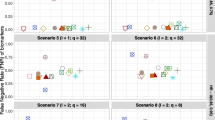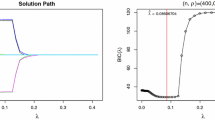Abstract
In many applications, covariates can be naturally grouped. For example, for gene expression data analysis, genes belonging to the same pathway might be viewed as a group. This paper studies variable selection problem for censored survival data in the additive hazards model when covariates are grouped. A hierarchical regularization method is proposed to simultaneously estimate parameters and select important variables at both the group level and the within-group level. For the situations in which the number of parameters tends to ∞ as the sample size increases, we establish an oracle property and asymptotic normality property of the proposed estimators. Numerical results indicate that the hierarchically penalized method performs better than some existing methods such as lasso, smoothly clipped absolute deviation (SCAD) and adaptive lasso.
Similar content being viewed by others
References
Aalen O. A model for non-parametric regression analysis of counting processes. In: Klonecki W, Kozek A, Rosinski J, eds. Mathematical Statistics and Probability Theory. Lecture Notes in Statist, vol. 2. New York: Springer-Verlag, 1980, 1–25
Antoniadis A, Fan J. Regularization of wavelet approximations. J Amer Statist Assoc, 2001, 96: 939–967
Cai J, Fan J, Li R, et al. Variable selection for multivariate failure time data. Biometrika, 2005, 92: 303–316
Cox D R. Regression models and life-table (with discussion). J Royal Statist Soc Ser B, 1972, 4: 187–220
Dave S S, Wright G, Tan B, et al. Prediction of survival in follicular lymphoma based on molecular features of tumor-infiltrating immune cells. N Engl J Med, 2004, 351: 2159–2169
Fan J, Li R. Variable selection via nonconcave penalized likelihood and its oracle properties. J Amer Statist Assoc, 2001, 96: 1348–1360
Fan J, Lv J. Non-concave penalized likelihood with NP-dimensionality. IEEE Trans Inform Theory, 2011, 57: 5467–5484
Fan J, Peng H. Nonconcave penalized likelihood with a diverging number of parameters. Ann Statist, 2004, 32: 928–961
Frank I E, Friedman J H. A statistical view of some chemometrics regression tools (with discussion). Technometrics, 1993, 35: 109–148
Friedman J, Hastie T, Höfling H, et al. Pathwise coordinate optimization. Ann Appl Statist, 2007, 1: 302–332
Huang J, Ma S, Xie H, et al. A group bridge approach for variable selection. Biometrika, 2009, 96: 339–355
Leng C, Ma S. Path consistent model selection in additive risk model via lasso. Stat Med, 2007, 26: 3753–3770
Lin D Y, Ying Z L. Semiparametric analysis of the additive risk model. Biometrika, 1994, 81: 61–71
Ma S, Huang J. Clustering threshold gradient descent regularization: with applications to microarray studies. Bioinformatics, 2007, 23: 466–472
Martinussen T, Scheike T. Covariate selection for the semiparametric additive risk model. Scand J Statist, 2009, 36: 602–619
Wang S, Nan B, Zhou N, et al. Hierarchically penalized Cox regression for censored data with grouped variables and its oracle property. Biometrika, 2009, 96: 307–322
Yuan M, Lin Y. Model selection and estimation in regression with grouped variables. J Royal Statist Soc Ser B, 2006, 68: 49–67
Zhao P, Rocha G, Yu B. Grouped and hierarchical model selection through composite absolute penalties. Ann Statist, 2009, 37: 3468–3497
Zhou N, Zhu J. Group variable selection via hierarchical lasso and its oracle property. Stat Interface, 2010, 3: 557–574
Zou H. The adaptive lasso and its oracle properties. J Amer Statist Assoc, 2006, 101: 1418–1429
Zou H, Zhang H. On the adaptive elastic-net with a diverging number of parameters. Ann Statist, 2009, 37: 1733–1751
Author information
Authors and Affiliations
Corresponding author
Rights and permissions
About this article
Cite this article
Liu, J., Zhang, R. & Zhao, W. Hierarchically penalized additive hazards model with diverging number of parameters. Sci. China Math. 57, 873–886 (2014). https://doi.org/10.1007/s11425-013-4679-9
Received:
Accepted:
Published:
Issue Date:
DOI: https://doi.org/10.1007/s11425-013-4679-9
Keywords
- additive hazards model
- group variable selection
- oracle property
- diverging parameters
- two-level selection




